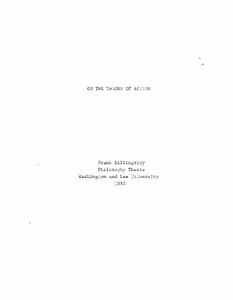| dc.rights.license | In Copyright | en_US |
| dc.creator | Billingsley, Franklin Patrick | |
| dc.date.accessioned | 2023-04-21T19:15:45Z | |
| dc.date.available | 2023-04-21T19:15:45Z | |
| dc.date.created | 1982 | |
| dc.identifier | WLURG038_Billingsley_thesis_1982 | |
| dc.identifier.uri | https://dspace.wlu.edu/handle/11021/36133 | |
| dc.description | The title page of this thesis simply labels this as a Philosophy Thesis. | en_US |
| dc.description.abstract | This paper concerns several points of action theory. I begin with a discussion of Arthur Dante's thesis on basic and nonbasic action, clarifying and differentiating between, the two. While Danto advances the notion of nonbasic action: Donald Davidson denies the existence of any action other than basic (or primitive) action. He claims all else to be only a redescription of primitive action; a claim challenged by the apparent confusion between language and descriptive language. Joel Feinberg's 'accordion effect' is also considered in Part I of the essay and,although I find the theory relatively sound, there are� dangers to be acknowledged. In Part II, I discuss the notion of one act falling under several descriptions. Considered here are the theories of G.E.M. Anscombe, J.L. Austin and Davidson. I discuss objection to the theories advanced by the two latter and clarify the difference between the approaches
taken to the problem by Anscombe and Davidson. Part III turns to the idea of finding intention in all actions and how that claim follows from the notion that all actions are basic. I consider cases of doing one thing by doing another (By Xing, he Y'd and Z'd) and the case of gesticulating while talking. I conclude with a discussion advancing the idea that actions are neither intentional or unintentional and that those two descriptions should be reserved for the results of action rather than the action themselves. [From introductory section] | en_US |
| dc.format.extent | 32 pages | en_US |
| dc.language.iso | en_US | en_US |
| dc.rights | This material is made available for use in research, teaching, and private study, pursuant to U.S. Copyright law. The user assumes full responsibility for any use of the materials, including but not limited to, infringement of copyright and publication rights of reproduced materials. Any materials used should be fully credited with the source. | en_US |
| dc.rights.uri | http://rightsstatements.org/vocab/InC/1.0/ | en_US |
| dc.title | On the Theory of Action | |
| dc.type | Text | en_US |
| dcterms.isPartOf | WLURG38 - Student Papers | |
| dc.rights.holder | Billingsley, Franklin Patrick | |
| dc.subject.fast | Act (Philosophy) | en_US |
| dc.subject.fast | Intention (Logic) | en_US |
| local.department | Philosophy | en_US |
